For good or for bad, it doesn’t look like the Pokémon Go craze is going away anytime soon. Luckily, you can, perhaps should, and may have no choice but to use Pokémon Go to level up your organization’s community engagement.

Don’t cry! Playing Pokémon Go can help you connect with your community.
Even if a connection between Pokémon Go and your organization’s work seems tenuous or non-existent, you can’t ignore how the game is captivating many people in your local community. And, since Pokémon Go seems likely to stick around and may inspire a wave of imitators, understanding now how you can leverage this kind of opportunity can give you and your organization an advantage in the future.
What is Pokémon Go?
Pokémon Go is a smartphone game in which players, known as trainers, walk around the real world to catch cartoon creatures called pokémon. Some people call Pokémon Go augmented reality, and some will insist it’s not since it doesn’t “alter our perception” of reality.
Whatever you call it, Pokémon Go is the cultural phenomenon of the moment. Just days after it was released by developer Niantic on July 6, Pokémon Go became the biggest mobile game ever in the U.S.. It has captured the most daily active users, is retaining those users, and is getting people to spend more time on it than they do on Facebook, Twitter, Tinder, or Snapchat. It’s big. Really big.
6 Ways to Leverage Pokémon Go for Community Engagement
1. Play Pokémon Go
While you don’t need to know the difference between a Charizard and a Blaziken to use Pokémon Go for community engagement, you should get at least a little familiar with how to play the game.
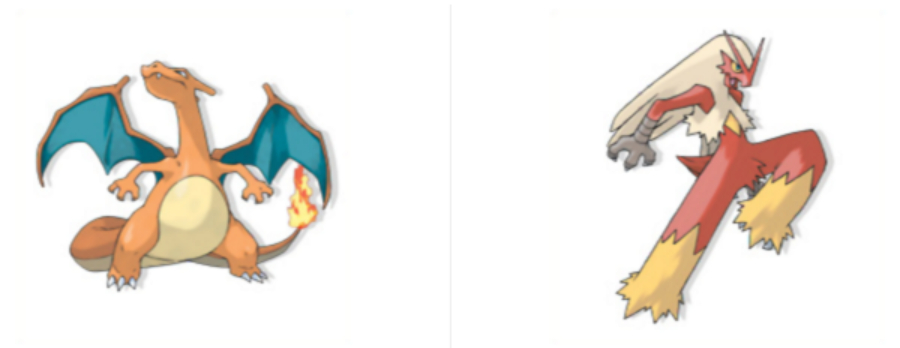
Here’s a Charizard (L) and a Blaziken (R). #TheMoreYouKnow
First, since you can only play on your mobile device, download Pokémon Go for free for iOS or Android. Then, charge your phone battery (and consider bringing an external battery pack) and put on comfortable walking shoes. Hush, walking is good for you.
As you stroll around, be on the lookout for creatures to capture. Your phone will vibrate when one is near. While hunting pokémon, take note of the game’s lingo and visual style. Seek out special game locations called pokéspots and gyms, especially if they’re at your organization’s homebase or favorite community outreach areas.
With a little practice, you’ll get the hang of how to play Pokémon Go. After all, it’s designed for kids and adults alike.
2. Share Pokémon Go-themed social content
Early reports indicate that Pokémon Go is attracting more than just stereotypical gamers. You can tap into the game’s broad appeal by publishing Pokémon Go-themed content on your organization’s social channels.
The simplest approach is to share screenshots of pokémon you find near your organization’s homebase or at relevant locations in your community. Take advantage of this communications hook to share something else interesting about your community or your organization.
Staff at the City of Las Vegas, Nevada Government hunted for pokemon, and shared their captures on the city’s blog and social media to encourage locals and visitors to explore the downtown neighborhood:
Our guide to Pokemon Go in #dtlv https://t.co/BzGo0dTRZt #PokemonGO #pokestop pic.twitter.com/aZmygcUSj6
— City of Las Vegas (@CityOfLasVegas) July 13, 2016
The Henderson County, Kentucky Tourist Commission published a Pokémon Go guide on its blog, and included tips for how people can continue to enjoy the spots once they’ve caught their creature. The commission has continued to share pokémon discoveries on its Facebook Page to boost local event attendance.
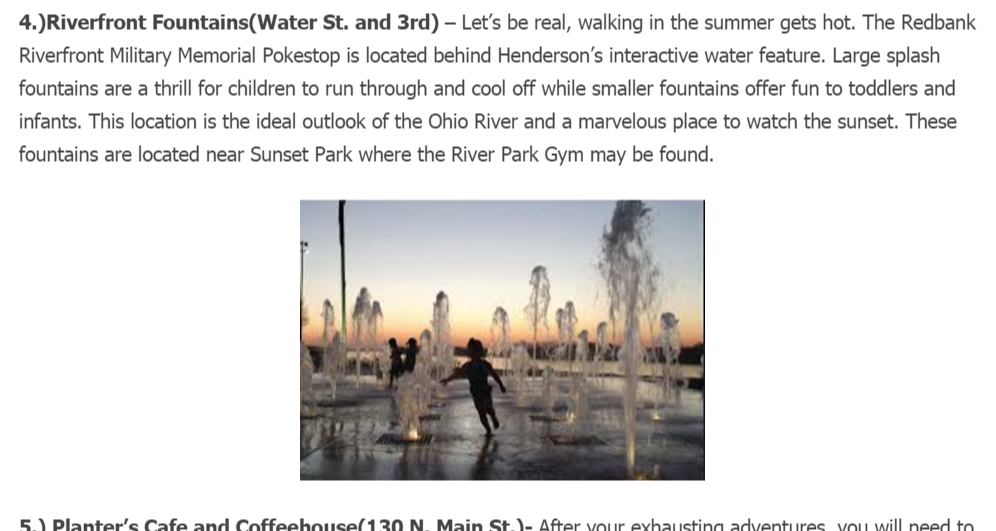
The Manchester, New Hampshire Police Department got a lot of attention with a clever Facebook post that invited people on the most wanted list to catch a rare pokémon. This single post went massively viral, and also showed off the police department’s sense of humor.
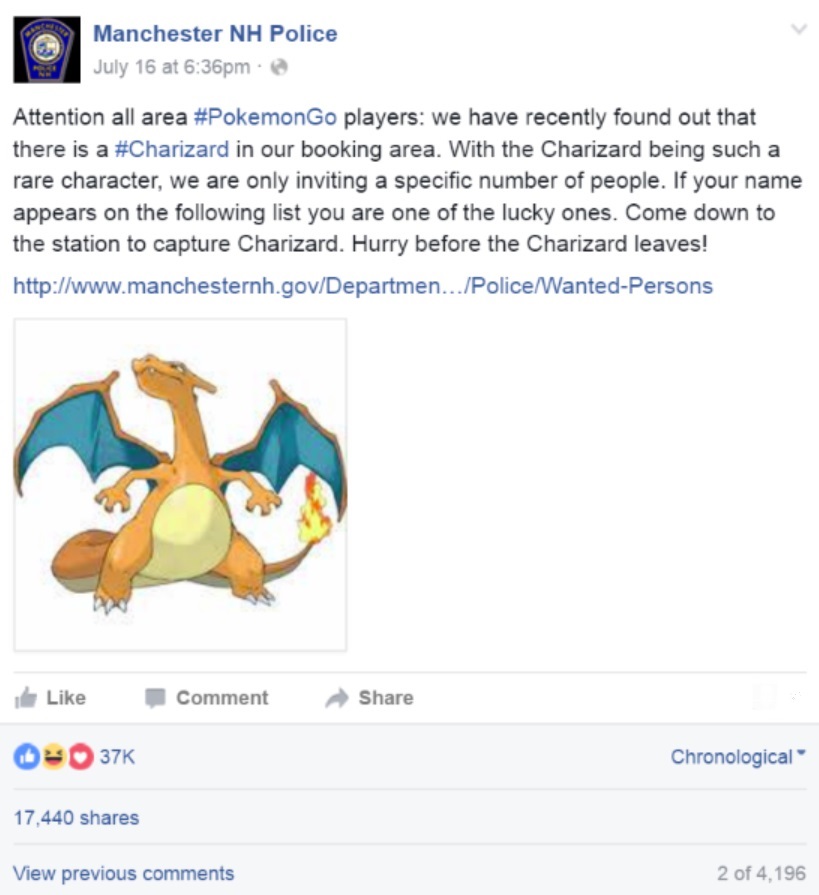
Be sure to add the hashtags #pokemongo, #pokemon, and, if appropriate, #pokestop to your social shares. Encourage players who come to your location to share their pokémon captures on social media and include your organization handle.
3. Keep Pokémon Go players safe
Players are out at all times of the day and night, and wandering around with their eyes glued to their phone screens. It’s not commonplace, but some players have put themselves at risk, and others have trespassed on closed or private property. You might find that your organization or agency has no choice but to talk to Pokémon Go players for reasons of public safety.
Even though Pokémon Go shouldn’t work if players are moving along at more than 20 miles per hour, several government agencies have had to ask people not to play while driving, including the Texas Department of Transportation:
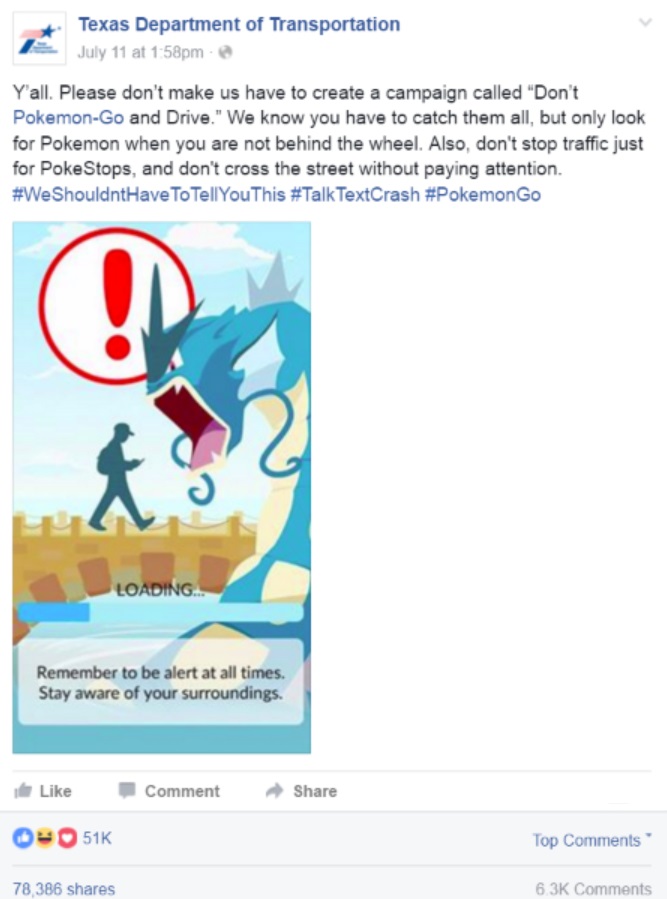
and the Arizona Department of Transportation:
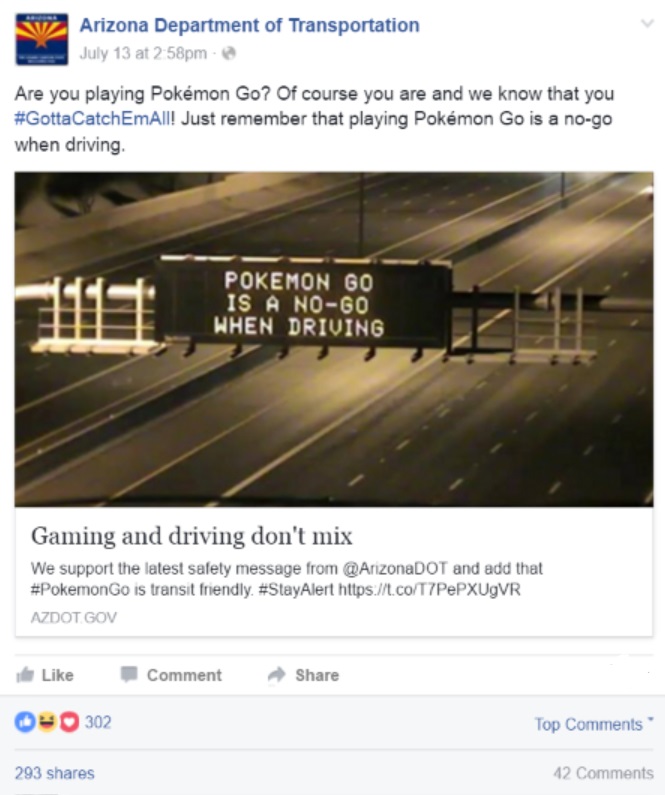
The Wyoming, Minnesota Public Safety Department has been sending pleas for common sense out on Twitter, mixed with a dose of laughter:
Located suspicious persons in a park after hours. Pokemon is to blame again. We're gonna start billing the Pokemon creators. #TweetTheBeat
— Wyoming (MN) Police (@wyomingpd) July 17, 2016
Never in my life have I ever thought that I would type the words #PokemonGO into a police report.
— Wyoming (MN) Police (@wyomingpd) July 12, 2016
Alright folks. He's blocking access to my squad. Not sure how to proceed. Need backup @ChisagoCountySO @ShakopeePD pic.twitter.com/rCyP0IPhlq
— Wyoming (MN) Police (@wyomingpd) July 11, 2016
The Duvall, Washington Police Department had to take to Facebook to warn locals against “creeping around” police headquarters:
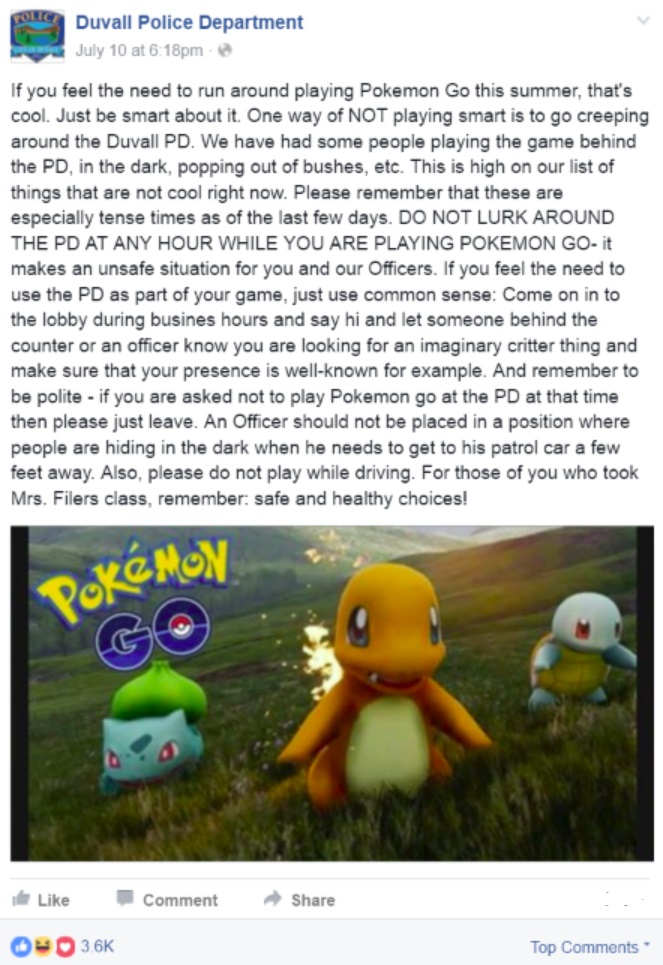
As Duvall police Sgt. Lori Batiot later added, “When I started in this profession never in my wildest dreams did I imagine that there would come a day when I would have to ask the public not to chase imaginary creatures behind the station at night.”
Many other agencies and organizations have been compelled to share Pokémon Go public safety messages, including police departments in Riley County, Kansas, New York City 19th Precinct, Goochland, Virginia, Phoenix, Arizona, Park Ridge, New Jersey, and the New York City Subway.
4. Deal with an unwanted Pokémon Go presence
Pokémon Go’s creators didn’t ask permission before they made locations into pokéstops and gyms. These popular game spots are usually found at points of interest like parks, libraries, police stations, churches, public art, sculptures, famous buildings, and historical landmarks.
Unfortunately, some pokéstops and gyms were placed where they really shouldn’t have been. Your organization may need to deal with players whose presence is unwanted or behavior is inappropriate.
The Arlington National Cemetery has had to ask people to stop playing to show respect for veterans and their families:
We do not consider playing "Pokemon Go" to be appropriate decorum on the grounds of ANC. We ask all visitors to refrain from such activity.
— Arlington National Cemetery (@ArlingtonNatl) July 12, 2016
Similarly, the U.S. Holocaust Museum and the 9/11 Memorial at the World Trade Center have also asked visitors to play Pokémon Go elsewhere, and have asked Niantic to remove pokéstops from their locations.
If you want your location removed as a pokéstop or gym, you can try submitting a request to Niantic. But, since there are no reports that that works yet, you’re better off asking your community to take their pokémon playing elsewhere.
5. Engage with Pokémon Go players in the real world
Local businesses and organizations that have gotten creative with Pokémon Go in the real world are seeing increased visits and sales. Even if your organization doesn’t have anything to sell, you can promote your programs and services. Or, you can invite people to learn more about what your organization does for the community.
The National Park Service at the National Mall and Memorial Parks is hosting a series of special Pokemon Hunt events to engage a whole new set of visitors and slip a little education in with the pokémon hunting:
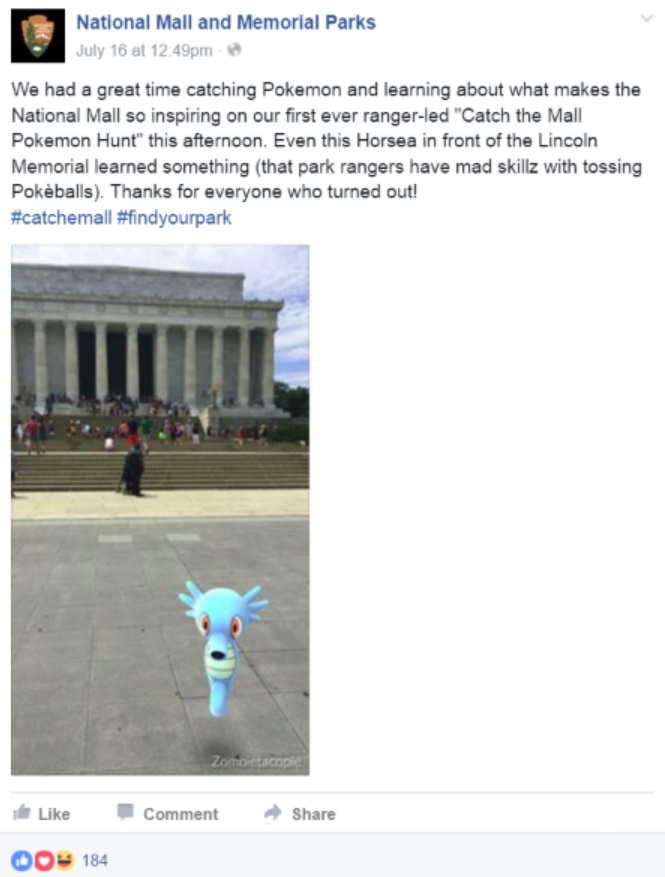
6. Add Pokémon Go to your social advertising toolbox
If your organization has a physical location that’s open to the public and near a pokéstop, you can entice Pokémon Go players to visit by buying Lure Modules. A Lure increases the number of pokémon that pop up in an area. More pokémon means players will seek your location out.
Lures are cheap, just $1.19 per hour per lure as an in-app purchase. If your organization office is a pokéstop, you can put a Lure right where you are. If you’re not at a pokéstop, look for one at your organization’s favorite spaces for community engagement activities.
In my New York hometown, East Meadow Public Library tempted players to pay a visit with hourly Lures:
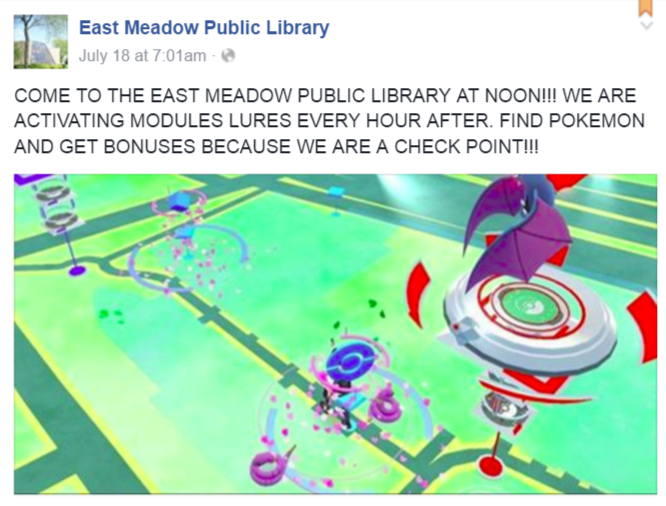
You’ll probably attract a crowd of Pokémon Go trainers with your Lure. Before you buy Lures, come up with creative ways to engage a group of people to interact with each other and with your organization.
For now, lures are the only in-game option you can buy. Sponsored pokéstop and gyms have not yet rolled out in the U.S., but they’re on their way.
What’s your Pokémon Go plan?
Is your organization or agency battling with ideas for how to use Pokémon Go to engage with your local community? Have you already connected with your constituents thanks to Pokémon Go? Share what you tried and what you learned in the comments!
Lauren Girardin is a marketing and communications consultant, writer, and speaker based in San Francisco. She helps organizations and do-gooders engage their communities and tell their stories. Her website is laurengirardin.com and you can connect with her on Twitter at @girardinl.





Lauren,
We were excited to see our blog referenced in your article! Thanks for sharing, well done!
– Henderson County Tourist Commission, Henderson Ky.
You’re welcome, Maddy. You’re doing a great job using Pokémon Go in Henderson County!